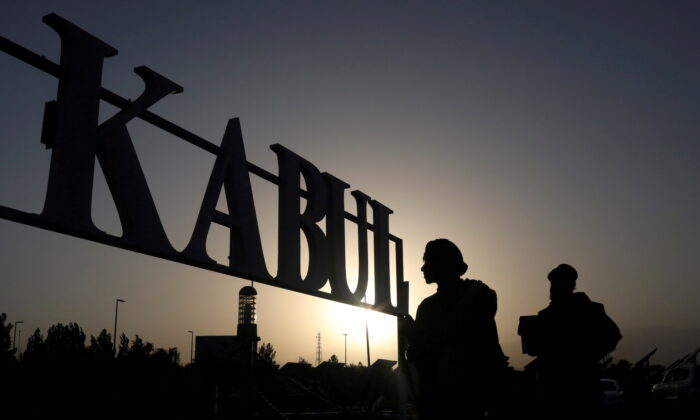
Taliban terrorists stand in front of a sign at the international airport in Kabul, Afghanistan, on Sept. 9, 2021. (West Asia News Agency/Reuters)
By
A recent oil deal between the Taliban and Beijing has raised concerns about communist China’s larger economic and geopolitical agendas in the violence-inflicted nation.
Experts say the Chinese regime wants to take advantage of the vacuum created by the American exit, eyeing more than $1 trillion worth of Afghanistan’s minerals including rare earth elements, while outwitting other regional competitors.
Taliban recently signed a 25-year contract with China’s Xinjiang Central Asia Petroleum and Gas Co (CAPEIC) to extract oil from an area of 4,500 square kilometers of Amu Dariya basin in Afghanistan’s three northern provinces of Sarpol, Jawzjan, and Faryab, according to a statement on Twitter by Zabihullah Mujahid, the spokesperson for the Taliban-run administration.
“The company (CAPEIC) will invest $150 million in one year and $540 million in the next three years. In this contract, the [Taliban administration] will be a 20% partner, and this share will increase to 75%,” said Mujahid. “About 3,000 Afghans will be employed in this project.”
The deal, which is the first agreement between the Taliban and any foreign company since the former took over Afghanistan in August 2021, ensures that oil is processed in Afghanistan, and termination can happen if the CAPEIC doesn’t meet its material obligations within a year.
Aparna Pande, a research fellow at the Washington-based Hudson Institute, said China has for decades been interested in gaining access to Afghanistan’s trillion dollars worth of natural resources, both energy and minerals.
“An unstable Afghanistan is fine by China as long as they have access to these resources and the regime keeps a curb on Uyghur activity,” Pande told The Epoch Times.
The erstwhile U.S.-backed Afghan regime signed a similar deal with the China National Petroleum Corporation (CNPC) to develop oil blocks in the Amu Darya basin in December 2011. Work on this project was halted in 2013 and the Chinese staff left the country after disagreements emerged about the transportation route of oil from Afghanistan to China. It was also under threat by the Taliban insurgency.
The Xinjiang branch of PetroChina was a subsidiary of CNPC and the CAPEIC was restructured from it in June 2000, according to the China Project.
Ahmad Rashid Salim, a best-selling author, community leader, and an academician in California who researches and teaches on topics in the fields of Islamic studies, Farsi literature, and Afghanistan, called it an “astonishingly bad deal” and said the de-facto Taliban regime doesn’t have the authority nor the public backing for the deal.
“The Chinese government with its historic and current record of violence and human rights abuses, especially against the Uyghur Muslims, is looking at the Doha deal between the Taliban and the U.S., as an excellent opportunity to sweep into Afghanistan and exploit the country’s natural and historical resources,” Salim told The Epoch Times in an email.
According to official figures (pdf), Afghanistan has 300 documented copper deposits with 30 million metric tons (MTs) of copper, 2.3 billion MTs of iron ore deposits in western Afghanistan along the Herat fault system through central Afghanistan and north of the Panjshir valley and possibly into Badakhshan, and 1.4 million MTs of rare earth materials.
Mining has also been the second largest revenue source for the Taliban after narcotics, according to multiple sources, and even before taking over Kabul. Taliban officials have previously gone on record about the group earning over $400 million annually from its overall mining operation. While it was operating mines in areas under its control, it was attacking mines under the control of the erstwhile Afghan regime.
The former Afghan regime had signed a $3 billion, 30-year agreement in 2008 with the Chinese state joint venture of Metallurgical Group Corporation (MCC) and Jiangxi Copper Ltd for mining operations at the Mes Aynak copper deposit near Kabul in Logar province. A 2000-year-old Buddhist heritage site also sits at the location.
The project faced logistics impediments from the very beginning and was halted in 2014 due to continued attacks and violence, including from the Taliban.
Five Afghan policemen died when the Taliban attacked a checkpoint at the Mes Aynak copper mine in March 2020. However, a year later when the Taliban took over Kabul, it tried to revive the same project with promises of adequate security to the Chinese.
Multiple meetings have reportedly already happened between the Taliban and MCC which is taking advantage of the situation and trying to renegotiate terms—reduce taxes and slash by half the 19.5 percent royalty rate owed to the Afghan government per ton of copper sold. The current status of the project is not yet clear.
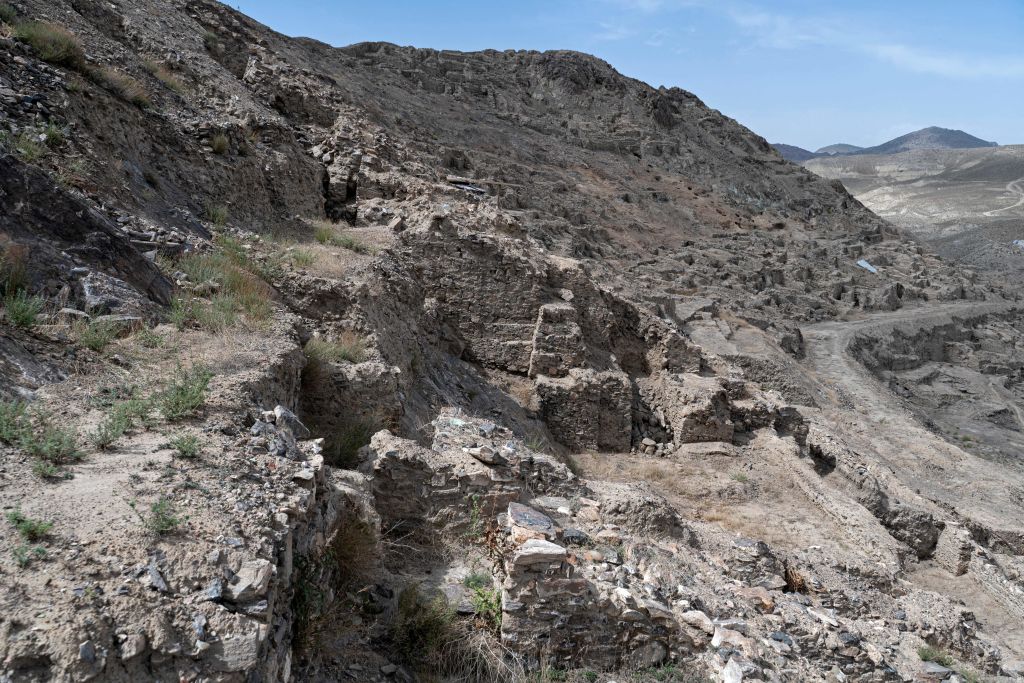
This photograph taken on May 17, 2022, show an archaeological site in Mes Aynak, in the eastern province of Logar. – An ancient Buddhist city carved out of immense peaks near Kabul is in danger of disappearing forever, swallowed up by a Chinese consortium exploiting one of the world’s largest copper deposits. (Wakil Kohsar/AFP via Getty Images)
Lifeline for the Taliban
Taliban has not been recognized as a legitimate regime by any nation, including Beijing, and is facing vulnerable times and increased violence from other militant groups like Islamic State who now threaten Taliban-operated mines.
Beijing has, however, accepted Taliban-appointed diplomats. While the recently signed oil deal has raised concerns about Beijing providing legitimacy to the Taliban, experts have refuted such claims.
“No, these deals do not legitimize the Taliban but they do show a willingness of China to work with the Taliban despite the danger to Chinese Nationals working in Afghanistan and the atrocious human rights record that the Taliban continues to uphold like banning girls and women from education and work and the recent return of public executions,” said Brent Edward Huffman, an American filmmaker who directed the 2015 documentary “Saving Mes Aynak.”
Huffman’s documentary played an instrumental role in bringing global focus on the Buddhist heritage site at risk from mining at Mes Aynak. The filmmaker expressed surprise that the oil deal was reached despite an attack by ISIS on a Kabul hotel that wounded five Chinese nationals in December.
“This new oil deal with Xinjiang Central Asia Petroleum shows this company believes this resource extraction, as well as future extraction at other sites, is potentially worth more than the safety of Chinese Nationals in Afghanistan,” said Huffman.
Chinese companies actually have larger plans for business expansion in Afghanistan after the Taliban approved the construction of a $216 million Sino-Afghan industrial estate on the outskirts of Kabul last April. The estate is expected to host 150 factories.
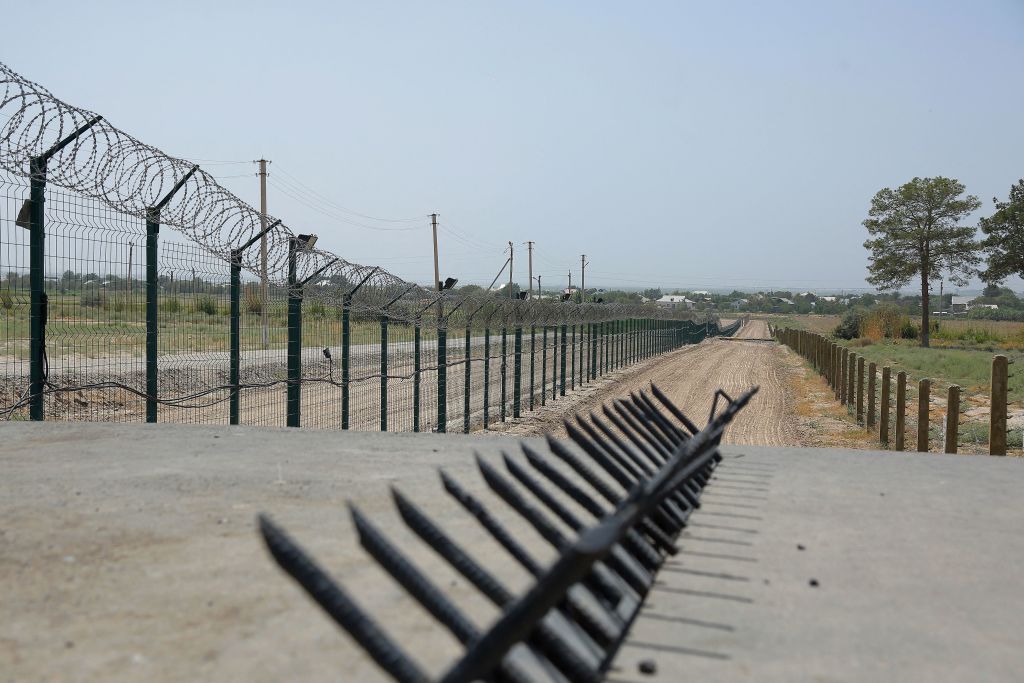
This picture taken on August 15, 2021, shows a barbed wire wall near a police checkpoint, two kilometers from “Friendship Bridge” over the Amu Darya River, which separates Uzbekistan and Afghanistan near Termez.(Temur Ismailov/AFP via Getty Images)
Lithium
With Chinese presence and its intentions to fill in the power vacuum left by the Americans, things thus appear more complex because China is eyeing more than just oil and copper. China has a near-monopoly on the global processing of rare earth elements and is interested in the Afghan lithium reserves.
This poses a strategic challenge to the United States’ and Europe’s green energy transition, according to Brookings think tank, which said in a report last year that the Afghan rare earth minerals could be of great significance for Chinese agendas.
Afghanistan’s lithium can be a crucial component of China-manufactured large-capacity batteries for electric vehicles and clean-energy storage systems. The nation also has other rare earth elements like copper, nickel, and cobalt, which could be China’s trump card for a transition to green energy sources, said a Brookings report titled “Chinese investment in Afghanistan’s lithium sector: A long shot in the short term.”
The country’s lithium reserves are so significant that they are said to potentially rival Bolivian reserves, currently the largest in the world. The Chinese are also a major investor in Bolivian reserves. But it’s not known if there’s currently a Taliban-China deal being negotiated on lithium extraction.
But China is not the only foreign investor in the Afghan mineral sector. There’s also buzz about other countries like Turkey, Russia, and Iran entering the arena.
Iranian ambassador to Kabul, Hassan Kazemi-Qomi told the Bazar news agency on Jan. 11 that the mining sector in Afghanistan currently provides good opportunities.
“Now is the best opportunity to invest in Afghanistan’s mines and we encourage Iranian investors to invest in Afghanistan,” said Kazemi-Qomi. Taliban’s Acting Minister of Mines and Petroleum Sheikh Shahabuddin Delawar also requested Iran for investments in the sector.
The Taliban has also suggested using Afghan minerals, including lithium, to pay for Russian oil imports. Taliban Minister of Industry and Trade Nuriddin Azizi last year headed a Taliban delegation to Moscow to boost trade ties and encourage investments and touted that Afghanistan has “very good and high-quality lithium.”
The Brookings report said that with this kind of competition for mineral resources already emerging in Afghanistan, the Chinese have already started to strategize to dominate the sector.
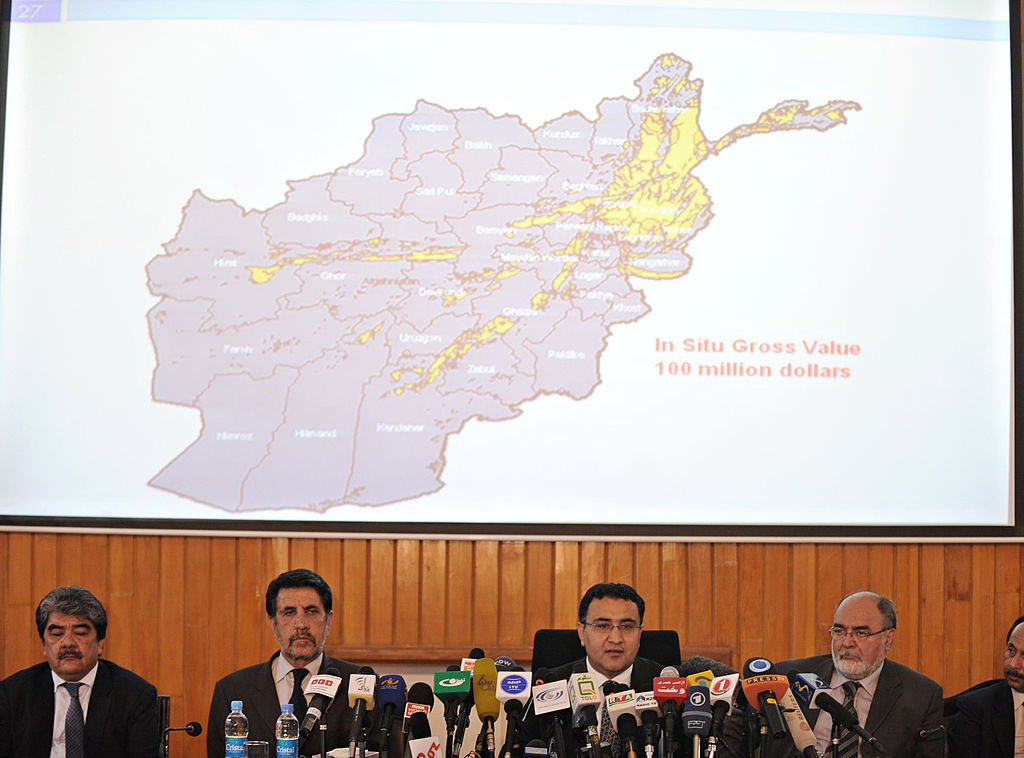
Afghanistan’s former Mining Minister Waheedullah Shahrani (C) from the erstwhile Afghan government addresses a press conference in Kabul on June 17, 2010. Shahrani said his country’s mineral deposits could worth up to three trillion USD, tripling an earlier estimate by US geologists. (SHAH MARAI/AFP via Getty Images)
The report added there’s limited information about any existing or future lithium extraction deals between the Taliban and Beijing.
“This suggests that while China is willing to acquire concessions, its primary interest may be blocking other players’ access to these resources,” it stated.
The report said that western investors are unlikely to enter the Afghan mining sector due to the risk of sanctions and thus the “leading candidate” to step forward would be China. This will obviously involve outbidding competitors.
Huffman agreed, saying that “China will likely have the deepest pockets and will outbid international competitors.”
Environmental Concerns
CAPEIC’s activities in the Central Asian Amu Dariya basin have drawn environmental concerns. In 2010, the same company signed a contract for a power generation and supply project for the part of the Amu Darya river basin located in Turkmenistan, just across the Afghan border.
The Amu Darya river basin, which covers territory in Turkmenistan and part of Tajikistan and Uzbekistan, Kyrgyzstan, and Afghanistan, is the largest gas-bearing basin in Central Asia and the third largest in the world.
The early years of the Great Game in the 1800s, a political and military confrontation between the former British and Russian empires over Afghanistan and surrounding areas, included many exploratory expeditions in the region including one to find the origin of the Amu Darya river.
The basin is thus already suffering from an ecological catastrophe with the Aral sea, which is connected with the Amu Darya, having shrunk to 40 percent of its original size in the last four decades. Many studies blame the former Soviet Union’s policies and pollution for this degradation.
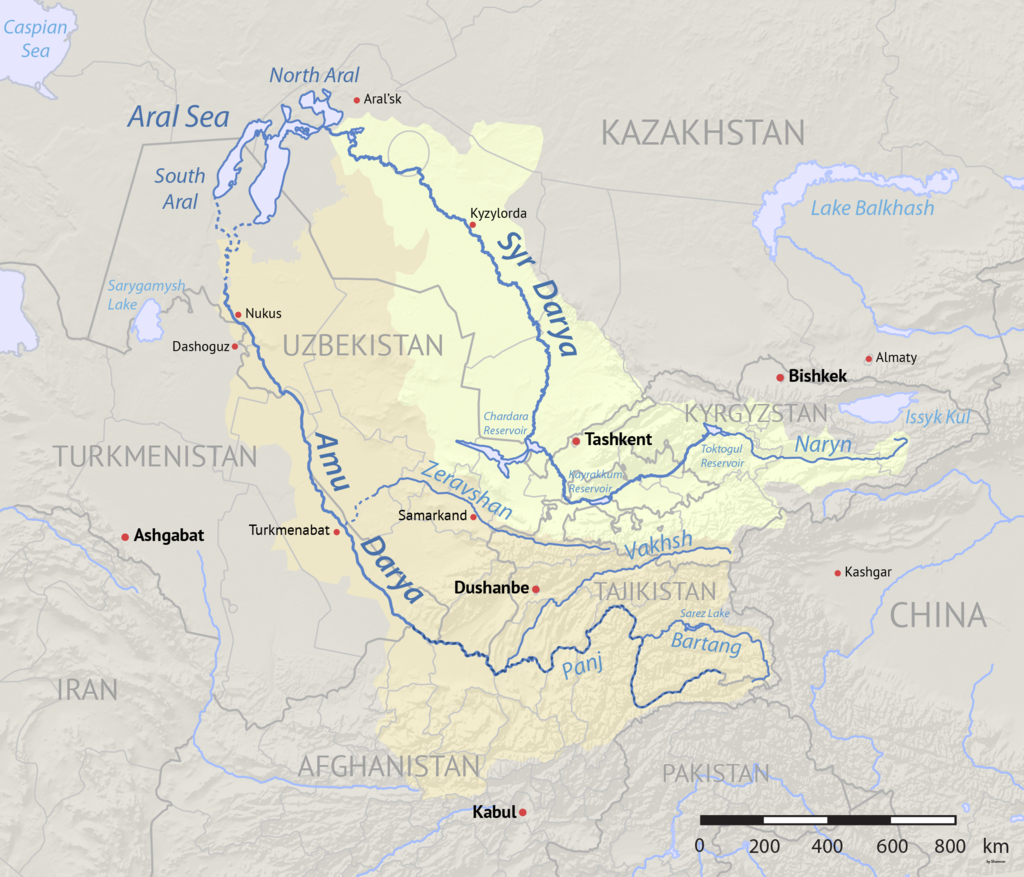
Map showing the location of the Aral Sea and the watersheds of the Amu Darya (orange) and Syr Darya (yellow) which flow into the lake. (Wikimedia Commons)
Experts believe that with China’s Belt and Road Initiative (BRI), a massive infrastructure investment project, targeting Central Asia including Afghanistan, the region today is more at risk than it was during the Great Game period or the Cold War.
“China is more strategic and pointed than the Soviets were,” said Pande.
The European Foundation for South Asian Studies (EFSAS), a Netherlands-based think tank, said in a commentary on Jan. 13 that China’s strategy in the region is consistent with its policy elsewhere to exploit vulnerable neighbors.
“That fits in perfectly with China’s consistent policy of preying on vulnerable and deeply distressed nations, mainly, but not exclusively, through entrapment in a vicious cycle of debt and steep repayment of debt via the BRI. Most other countries would view investments or projects in today’s Afghanistan as not being worth the risk in the existing unstable milieu, but not Beijing,” said EFSAS.
For its vested interests, the Chinese regime is thus not shy from signing deals with “pariahs” who until very recently were globally recognized as terrorists, it said.
Huffman is concerned that increased mining by the Chinese in Afghanistan will endanger the fragile ecology of the basin and also the many heritage sites in the country that need identification and conservation.
“There are ancient cultural heritage sites in nearly every corner of Afghanistan and deals like this threaten these sites and increase the risk of looting by the Taliban to sell to countries like China,” he said.
“I am sure ecological concerns like protecting the Amu Darya river are not part of these recently signed contracts. I imagine ecological devastation will be a major result of these new deals with the Taliban,” he added.
Venus Upadhayaya reports on wide range of issues. Her area of expertise is in Indian and South Asian geopolitics. She has reported from the very volatile India-Pakistan border and has contributed to mainstream print media in India for about a decade. Community media, sustainable development, and leadership remain her key areas of interest.